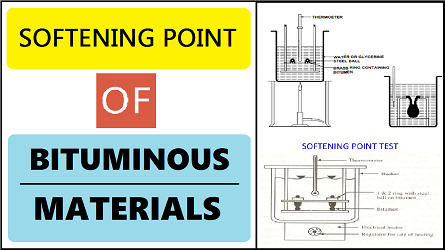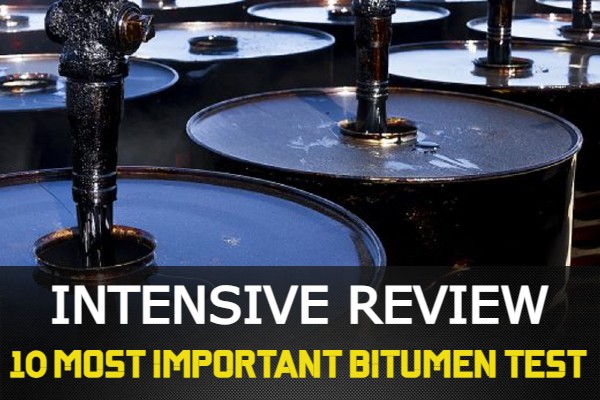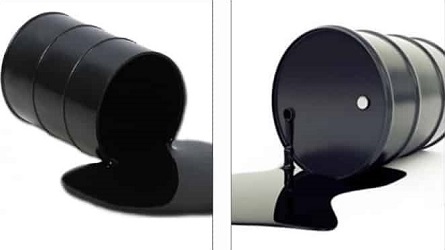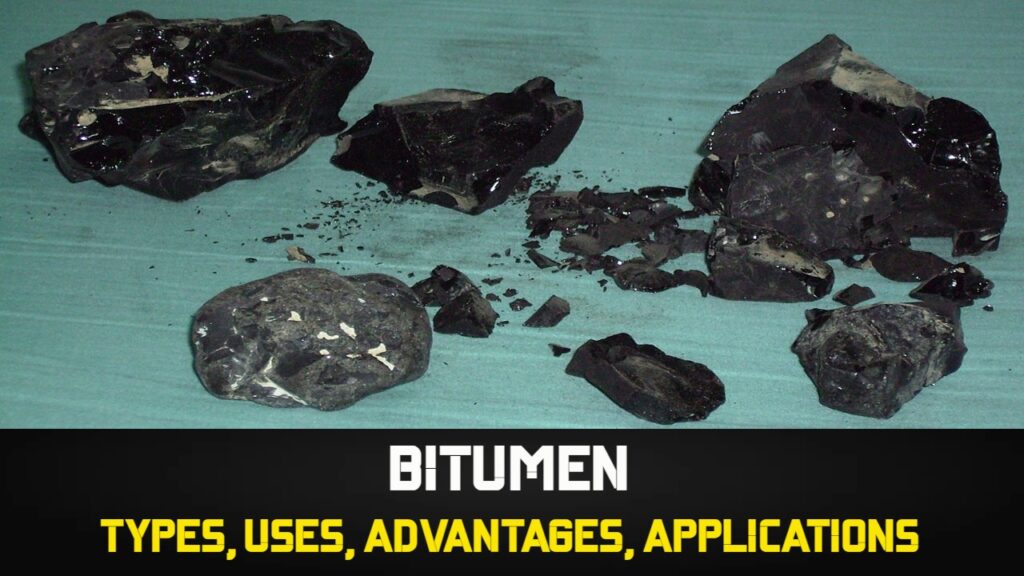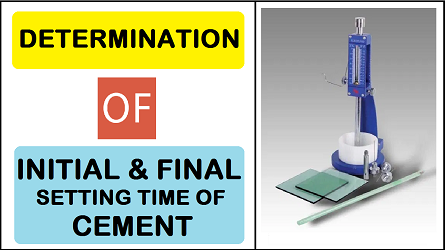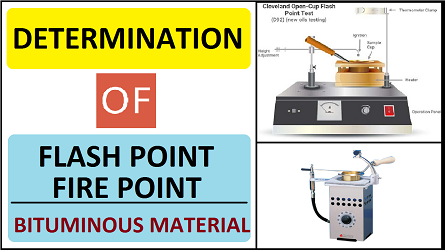Hello Friends, This is Mukesh from Learning Technology. I will tell you in today’s post, How to determine the Softening Point of Bituminous Materials in a very easy way.
Contents
Object of Experiment
To determine the Softening point of given bituminous material.
Theory and Scope
The softening point is the temperature at which the bitumen attains a particular degree of softening under the specified condition of the test. The binder should have sufficient fluidity before its use in road works. The determination of softening. indicates the temperature up to which a bituminous binder should be heated for various road applications. The softening point is determined by the ring and ball apparatus. According to IS: 334-1982, it is the temperature (in Celsius) at which a standard ball passes through a sample of bitumen in a mold heated underwater or glycerin at specified conditions of test and falls through a height of 25 mm. The concept of the softening point is illustrated in the figure.
Equipment
Pensky – Martens ring and ball apparatus
Bath
Low and high range thermometers
Stirrer
Heating system
The ring and ball Apparatus consists of
> Steel balls: Two Steel balls of 9.5 mm diameter and 3.5 ± 0.05-gram weight.
> Brass rings: Two tapered brass rings having a depth of 6.4 mm and inside bottom and top diameters of 15.9 mm and 17.5 mm respectively.
> Supports: To hold rings in position and also allows for the suspension of a thermometer. The distance between the bottom of the rings and the top surface of the bottom plate of the support is 25 mm.
> Bath: A heat resistant glass breaker not less than 85 mm in diameter and 1220 mm in depth.
> Thermometers : (a) Low range from (-) 7 degree Celsius to 110 degrees Celsius with an accuracy of 0.5 degrees Celsius. (b) High range from 90 degrees Celsius to 370 degrees Celsius with an accuracy of 2 degrees Celsius.
The digital thermometer may be used to minimize visibility error.
A heating system: An electric plate with an energy regulator is quite suitable.
READ MORE
- Aggregate Abrasion Value Test
- Flash and Fire Points of Bituminous Materials
- Determination of Flakiness and Elongation Index of Coarse Aggregates
- Stripping Value of Road Aggregate by Dynamic Immersion Method
- Determination of Efficiency of a Centrifugal Pump
- Calibration of V-Notch Experiment
- Aggregate Impact Value Test as per IS 2386 (Part-IV) 1993
- Aggregate Crushing Value Test
- Water Content of Soil by Oven Drying Method
- Specific Gravity of Cement by Specific Gravity Bottle
- Sp. Gravity & Water Absorption Of Coarse Aggregate
- Sp. Gravity & Water Absorption of Fine Aggregates
Procedure
Part 1: Preparation of test sample
1. Heat the bituminous material to a temperature between 75 degrees Celsius to 100 degrees Celsius above its softening point to obtain fluid consistency. Stir until it is completely free form air bubbles and water. Filter it through IS sieve 30, if necessary.
2. Heat the rings to a temperature approximately equal to that of the molten material. Place the rings on a metal plate. Coat the plate and inner surface of rings with a mixture of equal parts of glycerine and dextrine. Fill the material in the rings. After cooling, the rings filled with material for 30 minutes in the air, level the material in the ring by removing the excess with a warmed shape knife.
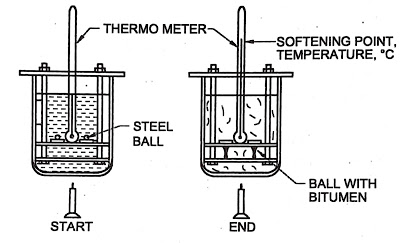
Part 2: Test procedure
1. Assemble the apparatus with the rings, thermometer and ball guides in position. Fill the bath with distilled water to a height of 50 mm above the upper surface of the rings. The starting temperature should be 5 ± 0.5 degrees Celsius.
2. Apply heat to the bath and stir the liquid with the help of a stirrer so that the temperature rises at a uniform rate of 5 ± 0.5 degrees Celsius per minute.
3. Apply heat until the bituminous material softens with the increase in temperature and the ball sinks through the ring, carrying a portion of the material with it.
4. Note down the temperature when any of the steel balls with bituminous coating touches the bottom plate. The temperature at which the ball touches the bottom is the softening point of that material.
Some specifications consider the temperature when the second ball also touches the bottom plate. The average of the two readings to the nearest 0.5 degree Celsius is reported as the softening point.
Note: For materials of softening point above 80 degrees Celsius instead of distilled water, glycerine is used to fill the bath and the starting temperature of the test is 35 degrees Celsius.
Observations and Calculations
| Binder Tested | ||
| Test Set up |
(I) |
(II) |
| Temperature when | ||
| (a) The first ball touches the bottom, oC | ||
| (b) The second ball touches the bottom, oC | ||
| Average | ||
Result
Softening Point = ……………….. Degree Celsius
Precautions
1. Wear safety glasses and/or face shields, heat-resistant gloves with close fittings cuffs.
2. There shall be no smoking or the presence of other ignition sources nearby of the test setup.
3. Check the samples for the presence of water while the material is still cold. If water is present drain off as much water as possible and allows the sample to dry at room temperature or blow dry with clean compressed air.
4. Distilled water should be used as the heating medium.
5. During the conduct of the test, the apparatus should not be subject to vibrations.
6. The bulb of the thermometer should be at about the same level as the rings.
Discussion
The softening point indicates the temperature at which binder posses the same viscosity. Bituminous materials do not have a definite melting point. Rather the change of state from solid to liquid is gradual and over a wide range of temperatures. The softening point has particular significance for materials that are to be used as joint and crack fillers. Generally, a higher softening point indicates lower temperature susceptibility. Between with the highest softening point may be preferred in hot climates as they will not flow during service. The softening point for various grades should lie within the range listed in Table.
Softening point for various grades of bitumen
|
Source of bitumen |
Bitumen from sources other than Assam petroleum |
Bitumen from Assam petroleum |
||||||||
|
Grade |
S-35 | S-45 | S-55 | S-65
|
S-90 | S-200 | A-35 | A-55 | A-65 | A-90 |
|
Softening Point oC |
50-65 | 45-60 | 45-60 | 40-55 | 35-50 | 30-45 | 55-70 | 45-60 | 45-60 | 35-50 |
